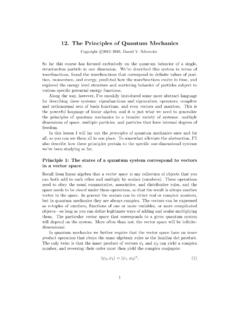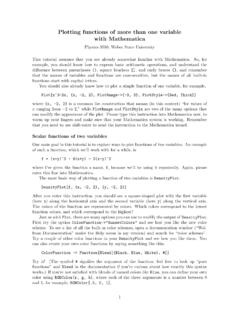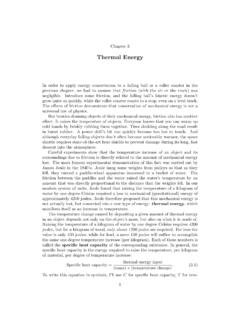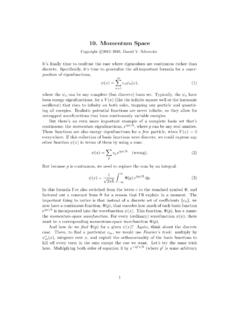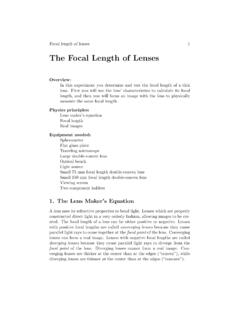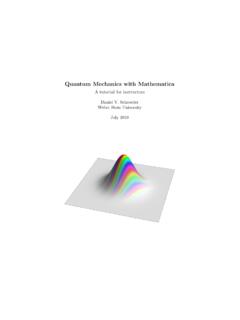Transcription of 2. Wavefunctions
1 2. WavefunctionsCopyrightc 2015 2016, Daniel V. SchroederTo create a precise theory of the wave properties of particles and of measurementprobabilities, we introduce the concept of awavefunction: a function of space thatencodes the current state of a now, we ll assume that the system consists of a single particle living in aone-dimensional universe. (We ll generalize to more complicated systems in a fewweeks.) Then, if this were aclassicalparticle, the state of the system wouldconsist of just two numbers: its positionxand its momentumpx(or velocityvx,which you can easily calculate from the momentum).
2 For aquantumparticle, thestate instead consists of thewavefunction (x), a whole infinity of numbers (onefor eachx). Quantum states are vastly more complicated, and interesting, thanclassical example wavefunctionFor example, if we draw thexaxis across the two-slit interference pattern illustratedin the previous lesson (and ignore the other two dimensions of space), then thewavefunction of each particle, just before it hits the detection screen, might looksomething like this:This wavefunction has five bumps, corresponding to the five bright lines in theinterference pattern.
3 The dark lines in the pattern are at the locations where thewavefunction is zero. More precisely, the brightness of the interference pattern isproportional to thesquareof the wavefunction, in analogy to the way the energy ina mechanical wave or an electromagnetic wave is proportional to the square of thewave amplitude. Here is a plot of the square of our five-bump wavefunction:1 The height of this graph at anyxis then proportional to the probability of find-ing the particle atx, when the subsequent interaction with the detection screen measures the particle s position.
4 After many such measurements are made onidentically prepared particles, the five-line interference pattern probabilitiesBecausexis a continuous variable, the actual probability of finding a particle at anyexactvalue ofxis infinitesimal. To get around this awkwardness, we can insteadask for the probability of finding a particlebetweentwo values ofx. We obtain thisprobability by calculating the corresponding area under the graph of| |2. For ageneric wavefunction, you can visualize the calculation like this:Written as an equation, the rule for calculating probabilities is to integrate:(Probability of findingparticle betweenx1andx2)= x2x1| (x)|2dx.
5 (1)The function| (x)|2is called theprobability density, and I like to think of it asa functionwhose purpose in life is to be integrated. In order for the rule to work,however, we must impose the condition that the total probability of finding theparticlesomewhereequals exactly 100%: | (x)|2dx= 1.(2)Any function that satisfies this condition is said to averagesSometimes, instead of calculating the probability of finding a particle at (or near)a particular location, we want to know itsaverageposition.
6 For example, theaveragexfor the five-bump wavefunction drawn above would be in the middle ofthe central bump, while the averagexfor the function drawn above equation 1would be somewhere to the right of the highest peak but to the left ofx1. I ll usethe symbol x to denote the average value figure out the general formula for x , it s helpful to first imagine that thevalues ofxare discrete, separated by intervals ofdx, so that the probability of anyparticularxiis| (xi)|2dx. Then the averagexis just the sum of all the possiblevaluesxi, weighted by their probabilities: x = ixi| (xi)|2dx x| (x)|2dx,(3)where in the last expression I ve taken the continuum can use a similar formula to calculate the average value of anyfunctionofx: f(x) = f(x)| (x)|2dx.
7 (4)A common example would be to compute the average value ofx2, which lets youthen calculate thestandard deviationofx, denoted x: x= x2 x 2.(5)This is a rough measure of the width or spread of a wavefunction. (If you needa review of the concept of a standard deviation, or don t know how to derive thepreceding formula, see any statistics textbook or Griffiths, Section )Although we commonly say that these average values apply to a single particlewhose wavefunction is , it s important to remember that if you actuallymeasurethe value ofx, you ll get some random value that may or may not be near theaverage, x.
8 It s therefore impossible to determine x (or x2 or x) with asingle measurement. To determine these quantities in the laboratory you must firstpreparemanyidentical particles in the same wavefunction , then measure all theirpositions and average the wavefunctionsAnynormalized function ofxis an allowed wavefunction, which you could use todescribe a quantum particle under suitable conditions. By afunction, I mean anysingle-valued graph that you can draw on a set of axes regardless of whether youcan write down a formula for a quantum particle is localized within a very small region of space.
9 Todescribe such a particle we would use a spiky wavefunction that s zero everywhereexcept in that narrow region:You could use a variety of formulas for such a function, but often the exact shapedoesn t matter, and it s convenient to take the limit where the spike becomes in-finitely narrow and infinitely tall to become aDirac delta function, denoted (x x0).Borrowing a word from German, we say that a delta function is aneigenfunction(which could be translated characteristic or particular function) of position,meaning that it s a function for which the particle s position is precisely defined.
10 Adelta function isnota properly normalized wavefunction, wavefunction with a single narrow spike is in some ways like a classical an equally valid wavefunction could havetwonarrow spikes, separated by a gap:This wavefunction has no classical counterpart, because it describes a particle thatis (apparently) half in one location and half in another and unambiguouslynothalf way in-between the two locations!However, just because a wavefunction is mathematicallyalloweddoesn t meanit s easy to physicallypreparea particle to have that wavefunction.

